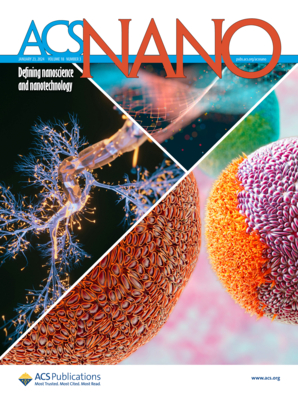工程微藻细胞外囊泡在预防放射性皮炎中增强线粒体稳态。
IF 16
1区 材料科学
Q1 CHEMISTRY, MULTIDISCIPLINARY
引用次数: 0
摘要
放射性皮炎是癌症放射治疗最常见的副作用之一,其特点是细胞氧化应激、线粒体损伤和炎症反应。在本研究中,我们从天然微藻螺旋藻(Spirulina platensis, SP)中分离出细胞外囊泡(extracellular vesicles, ev),并将虾青素(astaxanthin, AST)加载到SP- ev中,从而形成SP-EVs@AST。该工程体系显著提高了AST的溶解度和稳定性,同时保持了sp - ev的结构完整性和生物活性,从而实现了AST和sp - ev的互补和协同效应。SP-EVs@AST通过减轻氧化应激、恢复线粒体功能和减少炎症反应,证明了对辐射诱导的细胞损伤的保护作用。为了优化外用给药,将SP-EVs@AST加入由醛功能化透明质酸(HA-CHO)和羧甲基壳聚糖(CMCS)组成的自组装水凝胶中,形成皮肤辐射防护敷料(SP-EVs@AST凝胶)。这种敷料有效地保留了SP-EVs@AST的活性,促进了其持续释放,保护皮肤免受进行性辐射引起的损伤,并表现出长期的生物安全性。该系统展示了工程微藻电动汽车作为难溶性药物载体的潜力,为扩大其作为生物医学领域靶向给药平台的应用提供了一个有希望的策略。本文章由计算机程序翻译,如有差异,请以英文原文为准。
Engineered Microalgal Extracellular Vesicles for Enhancing Mitochondrial Homeostasis in Radiodermatitis Prevention.
Radiodermatitis, one of the most prevalent side effects of cancer radiotherapy, is characterized by cellular oxidative stress, mitochondrial damage, and inflammatory responses. In this study, we isolated extracellular vesicles (EVs) from the natural microalgae Spirulina platensis (SP) and engineered them by loading astaxanthin (AST) into SP-EVs, resulting in the formation of SP-EVs@AST. This engineered system significantly enhanced the solubility and stability of AST while preserving the structural integrity and biological activity of SP-EVs, thereby enabling the complementary and synergistic effects of AST and SP-EVs. SP-EVs@AST demonstrated protective effects against radiation-induced cellular damage by alleviating oxidative stress, restoring mitochondrial function, and reducing inflammatory responses. To optimize topical administration, SP-EVs@AST were incorporated into a self-assembled hydrogel composed of aldehyde-functionalized hyaluronic acid (HA-CHO) and carboxymethyl chitosan (CMCS), forming a skin radiation protection dressing (SP-EVs@AST gel). This dressing effectively preserved the activity of SP-EVs@AST, facilitated its sustained release, protected the skin from progressive radiation-induced injury, and exhibited long-term biological safety. This system demonstrates the potential of engineered microalgal EVs as carriers for poorly soluble drugs, offering a promising strategy to expand their application as a targeted drug delivery platform in biomedical fields.
求助全文
通过发布文献求助,成功后即可免费获取论文全文。
去求助
来源期刊

ACS Nano
工程技术-材料科学:综合
CiteScore
26.00
自引率
4.10%
发文量
1627
审稿时长
1.7 months
期刊介绍:
ACS Nano, published monthly, serves as an international forum for comprehensive articles on nanoscience and nanotechnology research at the intersections of chemistry, biology, materials science, physics, and engineering. The journal fosters communication among scientists in these communities, facilitating collaboration, new research opportunities, and advancements through discoveries. ACS Nano covers synthesis, assembly, characterization, theory, and simulation of nanostructures, nanobiotechnology, nanofabrication, methods and tools for nanoscience and nanotechnology, and self- and directed-assembly. Alongside original research articles, it offers thorough reviews, perspectives on cutting-edge research, and discussions envisioning the future of nanoscience and nanotechnology.
 求助内容:
求助内容: 应助结果提醒方式:
应助结果提醒方式:


